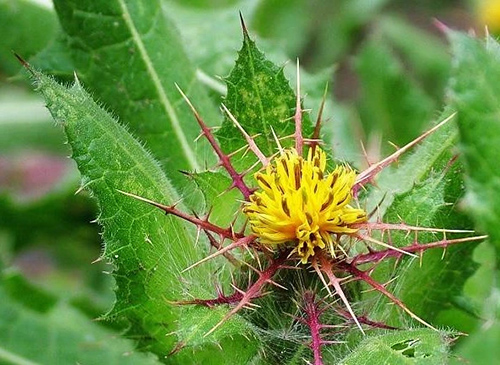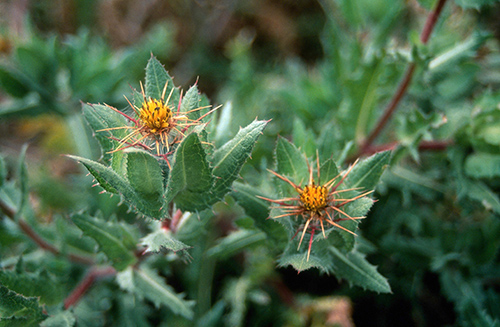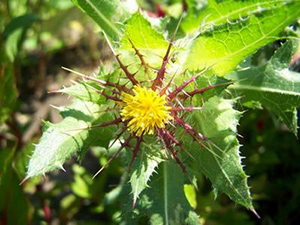Contents

The blessed thistle plant has been given the name of “holy” or “blessed” thistle, probably due to its many medicinal properties and generally its properties against the plague. However, it was used during the Middle Ages against this terrible ailment with more faith than success. In the 15th century, this plant was given to Emperor Frederick III of Germany, who suffered from acute migraines. After being regarded as a remedy for almost all diseases, current chemical and pharmaceutical research has revealed its applications.
Blessed Thistle Plant Scientific Facts
- Other names: St. Benedict thistle, holy thistle, Centaurea Benedicta L.
- French: Chardon benit.
- Spanish: Cardo santo.
- Environment: This plant is widespread all over Europe and Asia. Occasionally found in North America, as well as in Chile and Argentina. It usually grows in dry soils, slopes, and field borders.
- Description: Plant of the Asteraceae family, which grows from 20 to 50 cm high, with hairy stem leaves. The latter are large, with marked nerves on their underside. Its flower chapters are yellow, surrounded by reddish thorns.
- Parts of the plant used medicinally: The stem, leaves, and flowers.
Healing Properties and Warning

The blessed thistle plant contains a bitter component, cnicine, which stimulates the glands that secrete digestive juices in the stomach and the small intestine. This component gives the plant stomachic invigorator, digestive, and appetizer properties. It also promotes the functions of the liver and the pancreas, reducing the congestion and inflammation of both organs.
These properties are common to almost all plants containing bitter substances. However, the blessed thistle plant also has an actual amount of mucilage and tannin, enhancing its digestive system action. Thus, the indications of the plant are as follows:
- Digestive atony, lack of appetite, bloated stomach, and vomiting.
- Gastric hypoacidity, that is to say, lacks gastric juices in the stomach.
- Insufficiency of the liver and pancreatic function.
- Exhaustion and convalescence for weakening ailments.
- Diuretic and febrifuge, due to its content of flavonic substances and essential oils.
- Hypoglycemic: Recent research has proven that blessed thistle features an interesting hypoglycemic action, decreasing blood sugar levels. It is thus an excellent complementary treatment for people with type II diabetes.
- Antiseptic and wound healing when externally applied because of the antibiotic properties of its active component, cnicine. According to Fernandez y Nieto, this substance is effective against gram-negative bacteria, such as Brucella, Shigella, and Escherichia coli. It is used in cleansing wounds, and skin sores, and sitz baths for hemorrhoids.
WARNING! Herbal teas, when taken orally, must be prepared with low concentrations of the plant since they can produce a too-intense effect on the stomach and even vomiting. Please do not take more than the suggested dose because it will act as an emetic. Avoid use for the duration of the first two trimesters of pregnancy. It should not be utilized alone or in excess amounts for the remainder of the pregnancy.
Blessed thistle increases stomach secretions making it an excellent stomach tonic. It also helps to strengthen the heart, making it a remarkable heart tonic as well. The plant also benefits circulation and aids in resolving liver conditions. The blessed thistle plant is also helpful for all kidney and lung problems. It acts as food for the brain, stimulates memory, and rejuvenates the appetite. It cleanses the blood and reduces inflammation. Combine it with burdock root and yellow dock for best results as a blood purifier.
The plant is also excellent for nursing mothers by increasing milk flow and various female disorders. To increase milk flow, combine the warm blessed thistle tea with marshmallow root and raspberry leaves in equal parts.
Warning! Please do not take more than the suggested dose because it will act as an emetic. Avoid use for the duration of the first two trimesters of pregnancy. It should not be utilized alone or in excess amounts for the remainder of the pregnancy.
The entire plant is used as a weak tea (two teaspoons to one cup of water) of dried flowering plant traditionally used in Europe to stimulate milk production, sweating, and appetite; diuretic. The blessed thistle plant also has a folk following as a remedy for many other conditions such as:
- Ringworm
- Jaundice
- Chilblains
- Suppressed menses
- Migraines
- Headaches
- Gout
- Deafness
- Colds
- Indigestion
- Boils
Experimentally, it stimulates and increases bile and gastric secretions, and it is anti-inflammatory and antibacterial. In Germany, it is approved by the government for the treatment of dyspeptic and appetite discomfort. The seeds have served as emergency oil seeds.

How to use Blessed Thistle
- Infusion or decoction with a handful of fresh or dry leaves (30-50g) per liter of water. Drink up to three cups daily with meals. If this herbal tea is too sour, sweeten it with some honey or brown sugar.
- Compresses soaked in a decoction prepared with a handful of leaves stems, and flowers per liter of water. Apply locally on the affected skin area.
- Sitz baths with the decoction above.
Infusion: Steep for five to fifteen minutes. Tincture: Take five to twenty drops as needed. Fluid Extract: Take ½ to one teaspoon as needed. Powder: Take five to ten #0 capsules (30 to 60 grains) as required.
Mexican Holy Thistle
Mexican holy thistle (Argemone mexicana L.), called in Mexico chicalote, has yellow flowers with four or six petals. It grows in the southern United States, in Mexico, and all over Central America. It belongs to the botanical family of the Papaveraceae (like the opium and the poppy plants).
It possesses similar properties to those of opium, even substituting this alkaloid. Its leaves and seeds are used in infusion because of their sedative, analgesic, and antitussive properties. They have a mild narcotic effect. The whole plant contains yellow latex, which is used in external applications against warts.
DISCLAIMER: All content on this website is presented solely for educational and informational objectives. It would be best to not rely on the information provided as a replacement for advice, diagnosis, or treatment from a qualified medical expert. If you are pregnant, nursing, or have any preexisting medical concerns, you should talk to your doctor before using any herbal or natural medicines.
REFERENCES
- George D. Pamplona-Roger, M.D. “Encyclopedia of Medicinal Plants.” George D. Pamplona-Roger, M.D. Encyclopedia of Medicinal Plants. Ed. Francesc X. Gelabert. vols. 2 San Fernando de Henares: Editorial Safeliz, 2000. 444,445. Print.
- Vance Ferrell Harold M. Cherne, M.D. The Natural Remedies Encyclopedia [Book]. – Altamont, TN: Harvestime Books, 2010. – Vol. Seventh Edition: 7: pp. 146.
